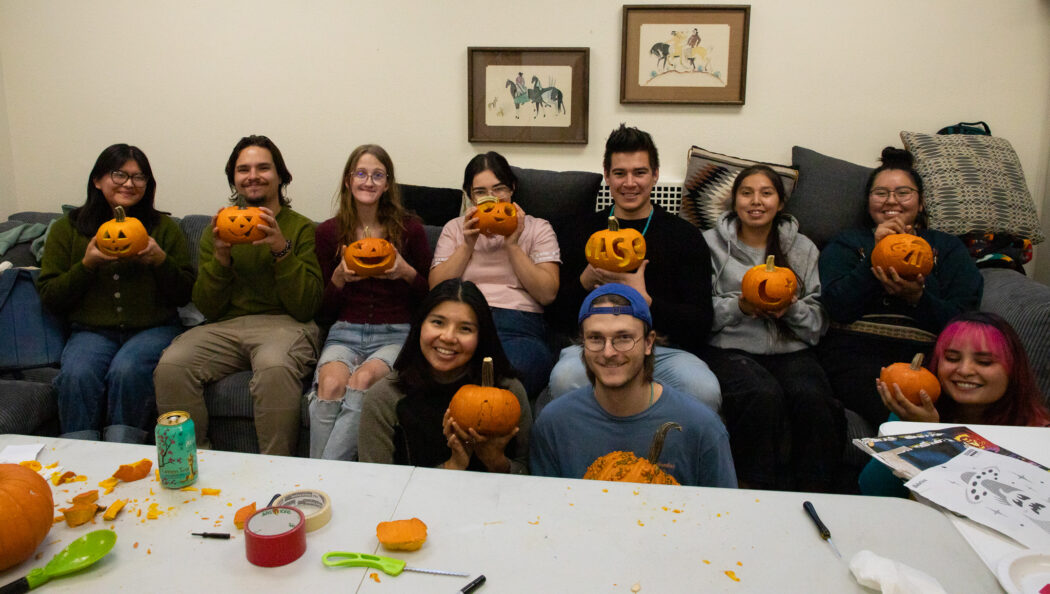Native American Student Council provides safe haven
The Native American Student Council, or NASC, at Utah State University makes inclusion and community its top priority. For years, the students of NASC have worked to create a space that feels inclusive, stress-free and celebratory of Native American culture.
Zoe John, a senior majoring in health education and promotion, is the president of NASC. This will be John’s first semester serving not only as an officer for NASC, but as primary leadership as well.
“I overlook everything and I coordinate plans with the other clubs,” John said.
For the past three years, NASC has been working hard to bring the council back in full swing with engaging events such as pumpkin carving nights, beading or important panels about the state of Indigenous people here in Utah.
“NASC kind of died down during coronavirus, and we’re trying to bring it back up,” John said. “We want to gain more recognition for Indigenous students and allies.”
According to their mission statement, NASC plays a foundational role in representing USU’s Native American population and providing a welcoming environment for Native and non-Native students alike.
John said the greatest benefit of NASC is the people.
“My favorite part of NASC is that it’s a community,” John said. “I’ve met so many cool people. Just getting to know other students that are struggling on campus as well, and providing them with a safe place to be them.”
Ashley Betony, a senior majoring in rangeland ecology and management, is in charge of public relations for the group. She values the bonds formed while being a part of NASC.
“We’re a very tight knit community,” Betony said. “It’s just a group of introverts that struggle and share our triumphs together.”
NASC often collaborates with other clubs. These kinds of events are among the favorites of members within the council because they are bigger and allow these students to simply be with one another.
“My favorite activity was collaborating with the outdoor programs,” Betony said. “We set up a camping trip and it was really nice to see everybody relax, especially before finals. We’re hoping to do that again this year.”
Club vice president William Clarke is a senior majoring in English literature. Alongside John, he assists in coordinating events and planning new activities for the council.
For Clarke, NASC is a way to meet and de-stress with other students.
“I’ve known the people on the council for a while, so it’s great to hangout with people that are awesome,” Clarke said. “I think it provides a space for people to relax, where people don’t have to have their guard up.”
Kris Pfeiffer, a first-year student earning his MBA in global communications, is serving as secretary for NASC. Pfeiffer is a member of NASC and recently became an officer.
“I really like the inclusivity we have. We always have something going on, or there’s always someone to talk to or something to do,” Pfeiffer said. “It keeps us quite busy, planning events and different panels, but I like that we’re able to promote our culture and make those who are either ignorant or unaware more informed.”
As secretary, Pfeiffer keeps records of membership, secures funding and helps prepare for all the events NASC puts on.
“We’re also kind of the point of resource or the authority on all things Native on campus,” Pfeiffer said. “Diversity, Equity and Inclusion panels will contact us about proper ways, the right people to go through or how we do certain things.”
NASC has been involved in a variety of events such as powwows and pageants.
“When I was here back in 2012, we used to do the princess pageant, Miss USU. That was really, really fun,” Pfeiffer said. “They had different talents they had to do; they did traditional dances in traditional dress. I always loved watching that.”
Five main nations make up the Indigenous population of Utah: Utes, Goshutes, Paiutes, Shoshone and Navajo. The majority of NASC represent the Navajo Nation.
According to historytogo.utah.gov, the Ute and Navajo nations are the largest of the five statewide, but historically the Northwestern Shoshone were the primary occupants of Logan. Communities such as NASC reflect this history and keep Native cultures alive in places where they have been otherwise uprooted.
“If you’re going to have a campus on Native land, you need to represent those Natives that have been displaced,” John said. “It’s important to bring more recognition to minorities and give them a voice.”
NASC is currently looking towards the future, constantly aiming at new ways to grow their community at USU.
“I really want NASC and other proposed Indigenous culture centers to expand,” Pfeiffer said. “Hopefully we can have more funding and broaden our umbrella and reach.”
According to USU’s Office of Analysis, Assessment and Accreditation, the number of Native American students enrolled at USU has grown rapidly within the last decade. Only 73 Native American students were enrolled in the 2010-11 school year, while fall 2022 enrollment statistics counted 397 students. NASC is hoping to reflect this change and welcome these students to an organization that celebrates their heritage.
“My goal is to get the two Native students that were here in 2011 to the 200 students that are here now involved in NASC and get them involved in more education and more awareness,” Pfeiffer said.
The Club Leadership concluded having a safe haven to celebrate culture freely and to simply have fun with a strong community has proved invaluable for the students of NASC.
“We want to revitalize the Native spirit and pride,” Pfeiffer said. “Bringing power back — that’s probably the main thing I want us to overcome.”

